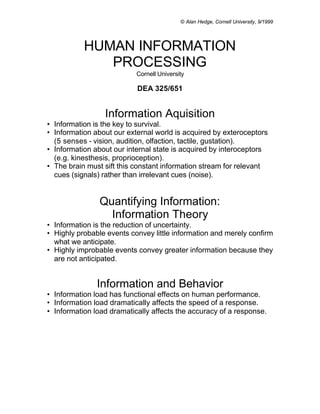
Hip
- 1. © Alan Hedge, Cornell University, 9/1999 HUMAN INFORMATION PROCESSING Cornell University DEA 325/651 Information Aquisition • Information is the key to survival. • Information about our external world is acquired by exteroceptors (5 senses - vision, audition, olfaction, tactile, gustation). • Information about our internal state is acquired by interoceptors (e.g. kinesthesis, proprioception). • The brain must sift this constant information stream for relevant cues (signals) rather than irrelevant cues (noise). Quantifying Information: Information Theory • Information is the reduction of uncertainty. • Highly probable events convey little information and merely confirm what we anticipate. • Highly improbable events convey greater information because they are not anticipated. Information and Behavior • Information load has functional effects on human performance. • Information load dramatically affects the speed of a response. • Information load dramatically affects the accuracy of a response.
- 2. © Alan Hedge, Cornell University, 9/1999 Information: Reaction Time • The speed of reaction to information depends on the time to: – Activate the sensory receptor – Transmit nerve impulses from the sense organ to the brain – Process nerve impulses in the brain – Transmit nerve impulses to muscles – Energize and activate muscles – Execute movement Simple Reaction Time • Simple reaction time (SRT): Stimulus Response • SRTs typically range between 150-200 milliseconds (0.15 - 0.2 seconds). • Auditory SRTs approx. 50 msec. faster than visual SRTs (at 55 mph this equates to ~ 4 feet difference in braking distance). Choice Reaction Times • When the operator has choices among alternative stimuli and/or responses (choice reaction time - CRT) then the information load affects reaction times. S1 R1 S2 R2 : : Sn Rn CRTs: Hick's Law (1952) • In making choices a person gains information at a constant rate: Mean CRT = K log2 (n+1) where n = number of choices +1 = has event occurred or not K = constant
- 3. © Alan Hedge, Cornell University, 9/1999 CRTs: Hick's Law Information Theory • Information is quantified in bits (binary digits), and represented by H • H = log2 N (number of alternatives) • With 2 alternatives H = 1 (log2 2=1) • With 4 alternatives H = 2 (log2 4=2) • With 8 alternatives H = 3 (log2 8=3) Information and CRT Information Theory • When alternative choices are not equiprobable, then the information associated with an even (Hi) is: Hi = log2 (1/p i) where p i = probability of i • For a series of events of differing probabilities: Hav = Ói=1 pi(log21/p i) Example • Assume 2 events of unequal probabilities, p 1=0.9 and p 2=0.1 Hav =[(0.1(log21/0.1))+(0.9(log21/0.9))] = 0.332 + 0.137 = 0.469 bit Redundancy • In information theory, redundancy is the reduction in information from the maximum information because of unequal probabilities of occurrence: % redundancy = (1 - (Hav/Hmax) x100 • From previous example: % redundancy = (1-(0.47/1.0) x 100 = 0.53 x100 = 53% • Because certain letter combinations are highly probable (th, qu, st) and others highly improbable (cw, tx, xq) the English language is ~68% redundant.
- 4. © Alan Hedge, Cornell University, 9/1999 Bandwidth • Bandwidth is the rate of information transmission over a channel. • Bandwidth of the eye is ~ 1,000 bits/sec • Bandwidth of the ear is ~ 10,000 bits/sec • Bandwidth of the brain is much lower than that of the sensory systems! • Most sensory information is filtered out of the system at a peripheral level to better match the capacity of the brain, which functions as a limited single channel capacity system. Functional Information Processing Information Storage and Retrieval Information Sensing Processing Action Output input Sensory Input • Sensory receptors transduce external energy in a limited spectrum into nerve impulses. • Sensory information is actively organized by perceptual processes to create and internal representation of our external world. • Perceptual organization occurs in a 'top-down' manner to impose order on sensory information. Perceptual Processes • Detection - determination of whether a stimulus is present or absent. Not a foolproof process. – False alarm - report that stimulus is present when absent. – Miss - report that stimulus is absent when present. • Recognition - noticeable familiarity without the ability to label the stimulus. • Identification - full identification of the stimulus (recognition + labeling).
- 5. © Alan Hedge, Cornell University, 9/1999 Perceptual Organization • Gestalt principles: – Proximity – Similarity – Closure – Continuity – Figure-ground • Constancies: • Size • Shape • Color • Brightness Constancies • Color - colors appear the same under a wide range of lighting conditions (e.g.snow looks white and coal looks black in sunlight or moonlight). • Brightness - object brightness looks the same under a range of lighting levels (e.g. the paper of a book looks white under low through bright light. Perceptual Processes • Perception - is an active process whereby the brain strives to make sense of sensory information and fit this to a known pattern. • Perception creates our reality. • Perception can easily be fooled to create illusions. Visual Illusions • Illusions can arise because of cue conflicts. Visual Illusions • Illusions can arise because of cue competition. Visual Illusions • Illusions can arise because of cue ambiguity. Visual Illusions • Illusions can arise because of cue orientation. Visual Illusions • Illusions can arise because of time and redundancy.
- 6. © Alan Hedge, Cornell University, 9/1999 Visual Illusions • Illusions can arise because of context. Visual Illusions • Illusions can arise because of mixed cues. Depth Perception • Linear environmental cues help with depth perception. Depth Perception • Environmental texture cues help with depth perception. Display Design • There are principles of perception that apply too each of the senses. • Ignoring the principles of perception can create dysfunctional information displays. • Knowledge of the principles of perception helps us to design more effective information displays.
